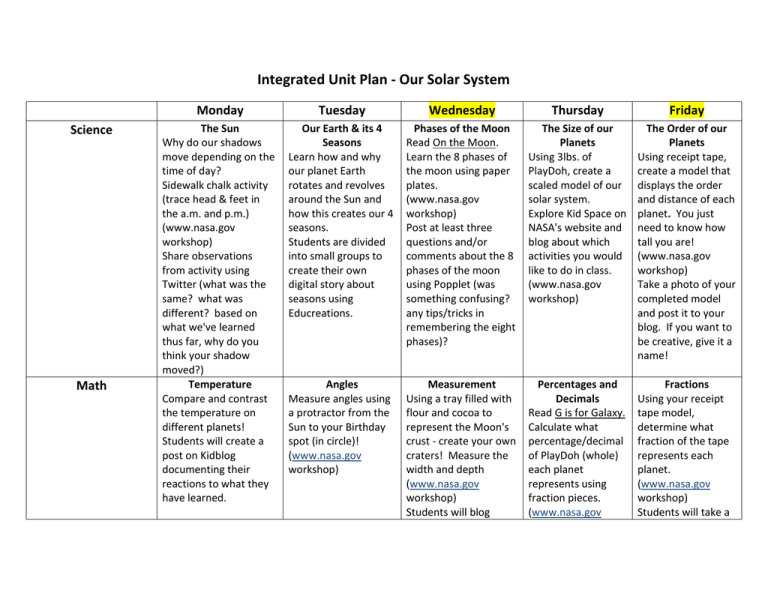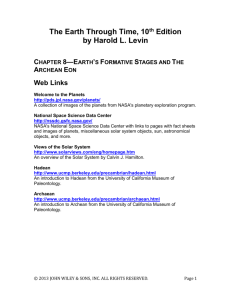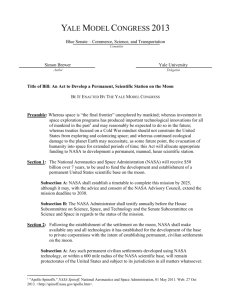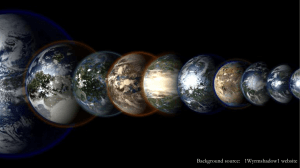Technology Unit Plan
advertisement

Integrated Unit Plan - Our Solar System Science Math Monday Tuesday Wednesday Thursday Friday The Sun Why do our shadows move depending on the time of day? Sidewalk chalk activity (trace head & feet in the a.m. and p.m.) (www.nasa.gov workshop) Share observations from activity using Twitter (what was the same? what was different? based on what we've learned thus far, why do you think your shadow moved?) Temperature Compare and contrast the temperature on different planets! Students will create a post on Kidblog documenting their reactions to what they have learned. Our Earth & its 4 Seasons Learn how and why our planet Earth rotates and revolves around the Sun and how this creates our 4 seasons. Students are divided into small groups to create their own digital story about seasons using Educreations. Phases of the Moon Read On the Moon. Learn the 8 phases of the moon using paper plates. (www.nasa.gov workshop) Post at least three questions and/or comments about the 8 phases of the moon using Popplet (was something confusing? any tips/tricks in remembering the eight phases)? The Size of our Planets Using 3lbs. of PlayDoh, create a scaled model of our solar system. Explore Kid Space on NASA's website and blog about which activities you would like to do in class. (www.nasa.gov workshop) The Order of our Planets Using receipt tape, create a model that displays the order and distance of each planet. You just need to know how tall you are! (www.nasa.gov workshop) Take a photo of your completed model and post it to your blog. If you want to be creative, give it a name! Angles Measure angles using a protractor from the Sun to your Birthday spot (in circle)! (www.nasa.gov workshop) Measurement Using a tray filled with flour and cocoa to represent the Moon's crust - create your own craters! Measure the width and depth (www.nasa.gov workshop) Students will blog Percentages and Decimals Read G is for Galaxy. Calculate what percentage/decimal of PlayDoh (whole) each planet represents using fraction pieces. (www.nasa.gov Fractions Using your receipt tape model, determine what fraction of the tape represents each planet. (www.nasa.gov workshop) Students will take a Language Arts Vocabulary Given a list of vocabulary words about the Sun and planets, make flash cards with a partner and quiz each other on spelling of words. Oral Presentation Tell about your favorite season using descriptive words and phrases. Students will create a "wordle" using their iPad. Social Studies/Technology Cultural Connection Read the article "Sun Dance" about Native Americans and work within small groups to identify the main idea and at least three supporting details. Geography Explore how the different seasons effect different states & their crops by filling in a map (on iPad). Use Map of U.S. activity on NASA's about what they thought was the coolest part! workshop) picture of their receipt tape model and tweet it. Creative Writing What would it be like to travel to the Moon in a shuttle? Create a digital story with team members pretending you are traveling to space. Use Pixlr to create an avatar that would live on the moon. Tweet your completed story for all to see! History Who was the first Man on the Moon and what year did he land there? Research this astronaut within small groups & be prepared to create a 10 slide power point. Poetry Tweet a creative acrostic poem that you have created about at least 2 planets in our solar system. (Whizbangers, Planet Poetry, pg. 232-233). Reading Read aloud Poor Pluto. Have a class discussion about the images in the story and how they relate to what we know about our planets. Students will blog using Kidblog about what they can infer about the planets. Research Using online databases, research your favorite planet (using at least 2 resources) - present information to the class. Students will How Our Planets Got Their Names? Go to nasa.gov and see what information you can find regarding planet names. Pick at least two to write Art/Music/Health SOL's Materials Health Learn about UV rays and how to protect yourself. UV beads & pipe cleaner bracelet activity. Take a picture of yourself wearing your bracelet outside & blog it. (www.nasa.gov workshop) Science: 4.8a, 4.8d Math: 4.9 L.A.: 4.4e Social Studies/Tech: VS.1h, VS.2e Health: 4.4d Science: Sidewalk chalk, website. Blog about your experience. (www.nasa.gov workshop) Create a hyperlink within your PowerPoint to a video on YouTube that is relevant. about. Record notes using iPad. Make sure to cite sources! (www.nasa.gov) Music Pick one instrument (drum, recorder, xylophone, chimes, etc.) that you think represents one of the four seasons and play something for the class. Be sure to explain why you think that instrument relates to that specific season! Science: 4.7a, 4.8a, 4.8b, 4.8d Math: 4.10a L.A.: 4.7j Social Studies/Tech: WG.1b, WG.1d Music: 4.5 Art Use Pixlr to create your own planet and post on Kidblog. Be as creative as possible! Music Write a song about your own imaginary planet & record it using YouTube. Use SoundCloud for ideas! Science: 4.7a, 4.8a, 4.8c Math: 4.7a, 4.7b L.A.: 4.7f, 4.7g, 4.7h, 4.7i Social Studies/Tech: C/T 3-5.7a Art: 4.10 Science: 4.7a, 4.7c, 4.8d Math: 4.3a, 4.3b L.A.: 4.7d, 4.7e Social Studies/Tech: C/T 3-5.6a, C/T 35.6b Music: 4.1 - 1 Science: 4.7a, 4.7b, 4.8d Math: 4.2c L.A.: 4.5h, 4.5i Social Studies/Tech: C/T 3-5.6a P.E.: 4.2b Science: On the Moon, Science: 3 lbs. of Science: receipt tape, Science: Hello, Harvest share their presentation using slideboom or slideshare (post link on Kidblog). Remember to include graphics Art Using WebStagram, create a Board to share with the class of all of the photos you have taken for this unit. Be as creative as possible & incorporate other technologies such as Pixlr, blog, twitter, etc.! clock, computer Math: Ruler, five sheets of paper, pencil, watercolor marker, computer L.A.: Vocabulary words, pencil, flash cards Social Studies/Tech: "Sun Dance" article, pencil and paper Health: pipe cleaners, UV ray beads, camera, computer Moon, by Ralph Fletcher, inflated Earth ball, inflated Sun ball, computer Math: Protractor L.A.: Four Seasons Make, a Year by Anne Rockwell, computer Social Studies/Tech: large sheet of drawing paper or a shower curtain, pencil, markers, computer Music: Musical instruments (music room) by Anna Milbourne, paper plates, print outs of 8 phases of the moon, glue, scissors, computer Math: aluminum baking tray, cocoa powder, glitter, flour, rocks of different sizes/weights, ruler, computer L.A.: resource books and/or access to the internet, pencil and paper, computer Social Studies/Tech: access to the internet and preapproved online databases, PowerPoint software, computer Art: 20 cotton balls,9 sheets of black construction paper, glue stick, 2 or 3 pieces of aluminum foil about 8 1/2 x 11 in., computer PlayDoh, ruler, string, paper, pen, computer Math: G is for Galaxy, by Janis Campbell & Cathy Collison, pencil, paper, fraction pieces L.A.: writing journal, pencil, resource books and/or access to the internet, computer Social Studies/Tech: access to nasa.gov, pencil and paper, computer Music: pencil, paper, computer pencil, market, ruler, computer Math: ruler, pencil, paper, receipt tape model, computer L.A.: Poor Pluto, by third grade students at Tokay Colony Elementary School, camera, computer Social Studies/Tech: access to the internet and preapproved online databases, computer Art: meter sticks, extra bases, baseball field, computer






